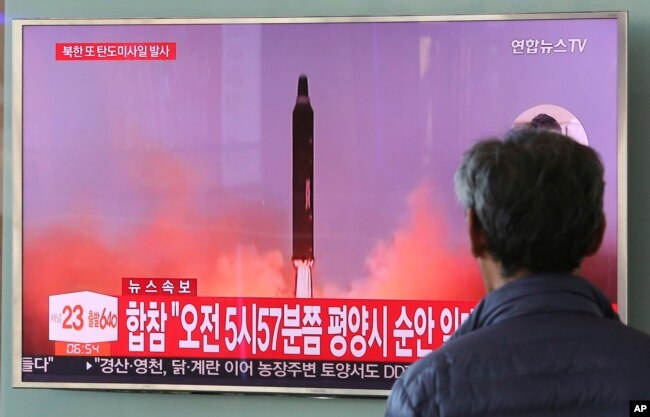
WHITE HOUSE — North Korea has acknowledged firing a ballistic missile over Japan, saying it was to counter current joint exercises by South Korea and the United States.In a Wednesday morning dispatch from Pyongyang the official Korean Central News Agency (KCNA) quoted leader Kim Jong Un the drill for the launch of the Hwasong-12 intermediate-range ballistic missile was “like a real war” and the first step by North Korea’s military for operations in the Pacific and “a meaningful prelude to containing Guam.”
President Donald Trump, earlier Tuesday in a statement said “all options are on the table” following the latest North Korean missile launch.
North Korea “has signaled its contempt for its neighbors, for all members of the United Nations, and for minimum standards of acceptable international behavior,” Trump said in a statement released by the White House.
Asked by VOA what he plans to do about North Korea, before boarding a helicopter at the White House Tuesday morning, the president replied, “We’ll see, we’ll see.”
Speaking ahead of an emergency meeting of the U.N. Security Council Tuesday evening, U.S. Ambassador Nikki Haley said diplomats “are going to talk about what else is left to do to North Korea.”
Haley said it is unacceptable that Pyongyang has “violated every single U.N. Security Council resolution that we had, and so I think something serious has to happen.”
Haley said she hoped “that China and Russia continue to work with us like they have in the past on North Korea.” However, she added, “I think enough is enough.”
WATCH: Amb. Nikki Haley on North Korea
U.S. intelligence officials said they see few signs that Pyongyang is likely to be deterred.
“North Korea has been conducting an unprecedented level of testing since early 2016 and we have not seen anything in their defiant posture to suggest that has changed,” one official told VOA on condition of anonymity.
U.S. defense officials said the North Korean missile, launched Tuesday from an air base near Pyongyang, landed in the Pacific Ocean, about 930 kilometers east of Japan.
The missile did not pose any threat to North America or to the Pacific Island of Guam, which North Korea has threatened in the past, U.S. officials confirmed. Still, the launch heightened concerns about the increasingly rapid pace of the North Korean missile program.
“We have to make the assumption that they continue to learn throughout each one of these missile launches,” the Pentagon spokesman, Colonel Robert Manning told reporters. He was speaking before Tuesday’s missile launch.
U.S. allies in the region are increasingly concerned about the crisis over North Korea.
Trump spoke by telephone with Japanese Prime Minister Shinzo Abe shortly after the launch occurred, Monday night in Washington. The White House said the leaders agreed North Korea poses a “grave and growing direct threat” to both countries.
There was no advance notice when North Korea launched the missile from near Pyongyang’s international airport. The rocket passed high above Japan less than 10 minutes after blastoff, then continued far out into the Pacific Ocean and broke into three pieces before it came down well east of Japan’s main northern island of Hokkaido.
In all, the missile flew an estimated 2,700 kilometers and was airborne for about 14 minutes, reaching a maximum altitude of 550 kilometers, according to Japan’s Ministry of Defense.
An August 25 launch of three short-range ballistic missiles had ended a month-long pause during which Pyongyang conducted no missile tests. U.S. officials interpreted that hiatus as “restraint,” prompting Trump to say last week that North Korean leader Kim Jong Un was “starting to respect us.” | via voanews

